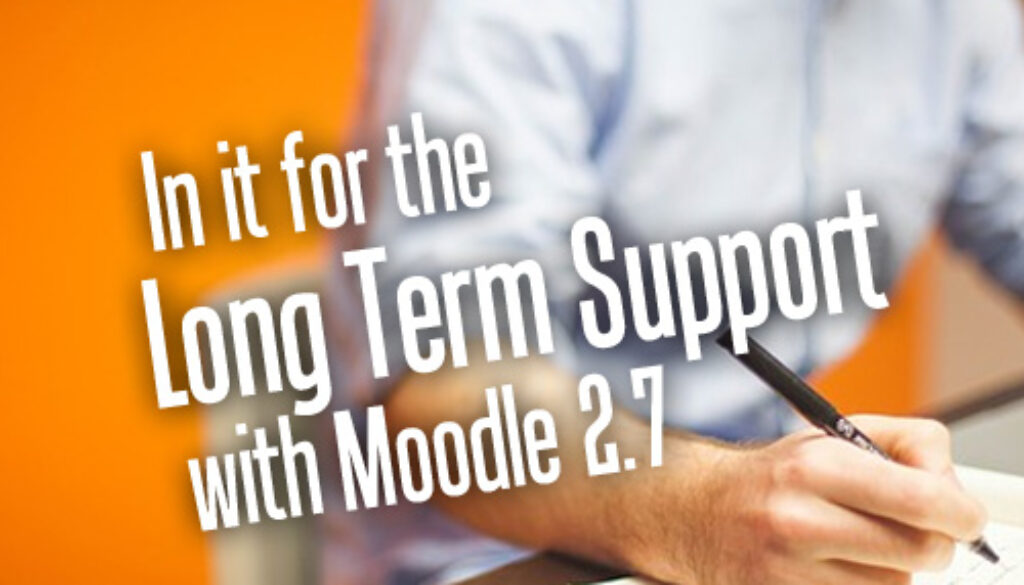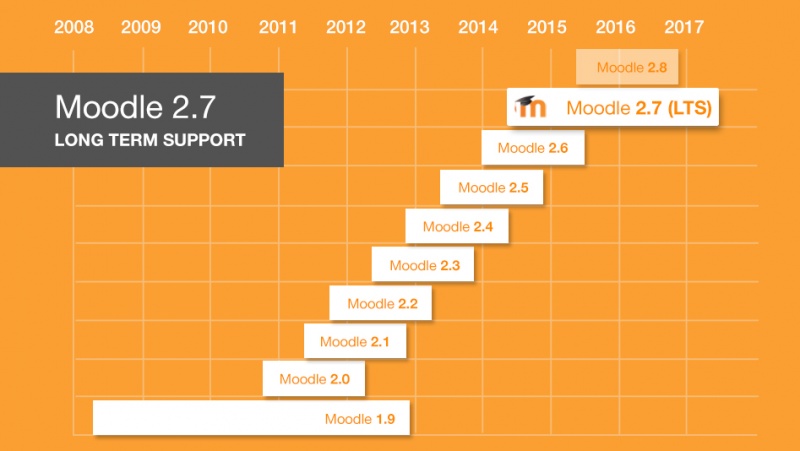Moodle for the Long Term – Moodle 2.7 LTS
Our favourite Virtual Learning Environment (VLE), the free and open source learning platform has just received an update (12 May 2014). The latest release, Moodle 2.7 is also a long-term support (LTS) release, a much welcomed news from Moodle HQ.
What is Long-term Support & Its Benefits
What this means is adopters of the VLE are given assurance that Moodle 2.7’s stable release will be around for a while, up to 3 years according to Moodle HQ, during which it will continue to be supported and maintained even when other new versions are on the scene. Yes, nothing stands still, Moodle 2.8 is earmarked for release next year.
Since Moodle 1.9, Moodle’s point updates were released so closely that many users find their learning platform out of date in matter of months and administrators constantly needing to keep their Moodle server up to date. We saw Moodle 2.1 and 2.2 in 2011, Moodle 2.3 and 2.4 in 2013, Moodle 2.5 and 2.6 in 2013.
While the push for frequent updates is good, keeping the product development life-cyle fresh, allowing for more features, improvements and stability, it all seems a bit harsh on the users as well as developers. Keeping Moodle 2.7 on long-term support (LTS), a common practice among open source software (e.g. Ubuntu, Joomla, TYPO3, CentOS and KDE) creates a stable platform for which to develop on.
Third party developers, administrators, theme designers, course creators, content designers, teachers and learners will have more freedom and space on which to build and apply their wares. This also means that, if you bought a Moodle guide book from Amazon, it won’t be out of date as soon as you received it. All in all a great ‘Moove’ by HQ.
So does it mean that we won’t be seeing new features from the Moodle Core. Yes and no, typical of software product lifecycle, the beginning of a Long-term Support period sees a feature freeze. This is to allow developers to make the software more stable and not have to worry about introducing new ones. This period allows for bugs and vulnerabilities to be identified and patched giving users the surety and stability.
Patches, point releases and maintenance releases sometimes introduces new features and new approaches to doing things. Windows 8.1 is a good example… and if we look at Moodle 1.9, it too has had many re-iterations and features. Also, don’t forget, we will begin to see more plugins such as activities, blocks and themes from willing and ready contributors to make your Moodle 2.7 feel polished and shiny for years to come.
Moodle 2.7 Overview
Here is a quick summary of what is new in Moodle 2.7
What is in store?
- Better user interface, more responsive and accessible with improved interface
- Boot strap based theme is now default
- Customisable ‘MORE’ theme that allows for easy customisation without needing to code in HTML or CSS
- Text editor: Atto, the new HTML editor promises to be closer integrated into Moodle and browsers
- Scalability and Performance: Large-scale solutions
- Improved Logging Framework: captures more data for analytics & reports on usage and learner activities
- Support for mobile notifications
- First long term support release: 3 years until May 2017 for security and data loss bug fixes
Wait, there is more…
Improvements in these areas:
- Conditional Activities supporting more boolean operations and plugins
- Quiz
- Assignment
- Better mathematics editing and display that is compatible with all browsers, tablets and smartphones
- Scheduled tasks that works even on complex clustered servers
- Gradebook
- Block docking returns
For more on New Features of Moodle 2.7, visit Moodle.org
Introducing the latest release, Moodle 2.7 is Moodle founder Martin Dougiamas in the following video:
Over to You
If you are as excited as we are, you would be looking to upgrade your Moodle server to Moodle 2.7 in the next month or so. Make sure you check the Upgrade notes and remember to create your backup.



